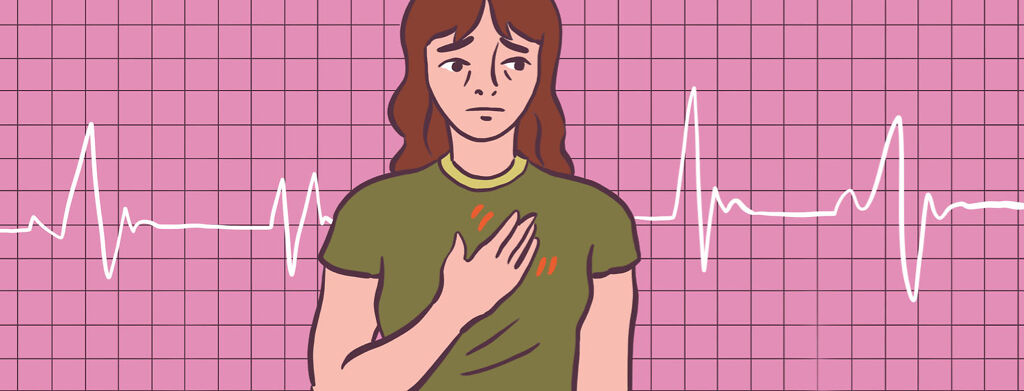Signs and Symptoms of Aortic Stenosis
Reviewed by: HU Medical Review Board | Last reviewed: May 2024 | Last updated: April 2025
Recognizing the signs and symptoms of aortic stenosis (AS) is critical. AS, when left undiagnosed and untreated, can lead to serious health risks like heart failure and even death.1,2
Aortic stenosis is when the aortic valve in the heart becomes narrowed, restricting blood flow from the heart to the rest of the body. Several things can cause it, but the most common cause is calcium buildup on the aortic valve due to aging. Most people diagnosed with AS are over the age of 65.1
Signs and symptoms of aortic stenosis
Aortic stenosis often develops slowly. Symptoms may not appear until the condition has progressed to a more advanced stage. Many people dismiss symptoms as normal signs of aging.1-3
If you do have symptoms, do not ignore them. Tell your doctor if you experience any of the following:1-3
- Chest pain – This is often described as a tightness, pressure, or squeezing sensation. Chest pain occurs because the heart must work harder to pump blood through the narrowed valve. This extra work can lead to chest pain.
- Shortness of breath – Difficulty breathing, especially during physical activity or when lying down, is a common symptom of AS. It is a sign that the heart is struggling to pump enough blood to meet the body’s needs.
- Fatigue – Persistent tiredness or feeling easily wiped out can result from reduced blood flow and the heart’s increased workload.
- Heart palpitations – An irregular, fast, or fluttering heartbeat may occur as the heart tries to make up for reduced blood flow.
- Dizziness or fainting – Reduced blood flow to the brain can lead to dizziness, lightheadedness, or fainting spells. This usually occurs during physical activity.
AS can show up differently in men and women. A 2022 study found that women may experience more dizziness and shortness of breath than other symptoms. The same study also found that women are more likely to think their symptoms are less severe than they actually are. This has led to underdiagnosis of AS in women.4
Stages of aortic stenosis
AS usually progresses slowly over time, becoming more severe as a person ages. The stages of AS are:2
- Mild – The aortic valve is slightly narrowed. There are usually no noticeable symptoms. You should get your heart monitored regularly by your doctor and control your risk factors by keeping your blood pressure, blood sugar, and cholesterol in check.
- Moderate– The heart is working harder to pump blood through the narrower valve. Symptoms may begin to appear. Lifestyle changes and medicines to control blood pressure may be needed.
- Severe – Significant narrowing of the valve has occurred. Symptoms like chest pain, shortness of breath, and fatigue are now noticeable. This stage often requires heart valve replacement surgery.
- Critical – Symptoms are severe, and the condition can become life-threatening without immediate treatment.
Diagnosis of aortic stenosis
Diagnosing AS involves several tests to confirm the condition and assess how severe it is:1,5,6
- Physical exam – A doctor will conduct a thorough physical exam. The exam may include listening for heart palpitations or a heart murmur and checking your blood pressure.
- Echocardiogram – This type of ultrasound is the primary tool for diagnosing AS. It provides detailed images of the heart’s structure and how it is working. These images can reveal any valve narrowing and how severe it may be.
- Electrocardiogram (ECG) – An ECG measures the electrical activity of the heart. It can detect whether the heart is enlarged or other abnormalities.
- Chest X-ray – This imaging test can show an enlarged heart or signs of heart failure.
- Stress test – This type of test helps determine whether AS symptoms occur during physical activity. Most stress tests involve walking on a treadmill or riding a stationary bike while the heart is monitored. If you cannot exercise, you may be given a medicine (dobutamine) that mimics the effects of exercise on the heart while you are monitored.
- Cardiac computed tomography (CCT) – CCT is a type of detailed imaging that looks at how much calcium buildup is in the aortic valve. It is a very helpful tool in treatment planning.
- Cardiac catheterization – While not typically used to diagnose AS, this could be used in some cases if other tests are inconclusive. During this procedure, a catheter is inserted into the heart to measure the pressure within the heart chambers and the aortic valve.
When to seek medical help
Prompt medical attention is crucial if you have any signs or symptoms of AS. Seek medical help if you notice:2
- Persistent chest pain or discomfort
- Unexplained shortness of breath
- Unusual fatigue or weakness
- Dizziness, lightheadedness, or fainting
- Heart palpitations
With early detection and treatment, most people with AS have a good prognosis and can live full and active lives. If you are over age 60, get your heart checked regularly.2

Join the conversation